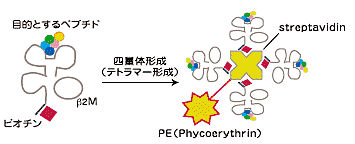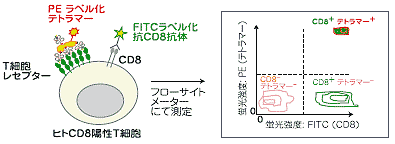テトラマー法について
テトラマー法では、まずMHC (major histocompatibility complex:主要組織適合遺伝子複合体) 分子と目的とする抗原ペプチドを結合し、
ビオチン化MHC class I / peptide complexの単量体化したものを調製します。
この単量体はそのままでは目的の細胞との結合力が弱くなることから、
PE (Phycoerythrin) ラベルされたstreptavidinと結合させ、四量体化 (テトラマー) とすることで結合力を高めています。(下図)

このテトラマーを用いた検査は、ウイルス感染細胞、ガン細胞等の除去に重要な役割を担っている細胞傷害性T細胞 (CTL:Cytotoxic T lymphocyte) の解析に非常に有用となります。
従来のCTL解析は、リンパ球中に占めるCD8の割合で評価してきましたが、テトラマー法を用いることにより、抗原特異的CTLを定量的に解析することができます。
このことは、感染症やガン患者の免疫状態をモニターする手段として免疫学的研究および、臨床上非常に有用となります。(下図)
 Julian K Hickling, Measuring human T-lymphocyte function,
Experimental Reviews of Molecular Medicine. 13, 1998.
Julian K Hickling, Measuring human T-lymphocyte function,
Experimental Reviews of Molecular Medicine. 13, 1998.
copyright (C) Cambridge University Press, reproduced with permission
About the tetramer method
In the tetramer method, MHC (major histocompatibility complex) is first bound
with a targeted antigenic peptide to prepare a monomerized biotinylated MHC class I / peptide complex.
If left as it is, this monomer reduces the strength that binds itself with a targeted cell:
thus it is bound with PE (Phycoerythrin) - labeled streptavidin to make it a tetramer and enhance the bonding strength.
(Bottom left figure)

Testing with this tetramer is very helpful in analyzing CTLs (Cytotoxic T lymphocytes),
which play a key role in eliminating virus-infected cells and cancer cells, among others.
While the conventional CTL analysis evaluates the ratio of CD8 in the lymphocytes,
the tetramer method allows us to quantitatively analyze antigen-specifi c CTLs.
This is very valuable both immunologically and clinically as a means to monitor the immune state of
a patient with an infectious disease or cancer. (Bottom figure)
 Julian K Hickling, Measuring human T-lymphocyte function,
Experimental Reviews of Molecular Medicine. 13, 1998.
Julian K Hickling, Measuring human T-lymphocyte function,
Experimental Reviews of Molecular Medicine. 13, 1998.
copyright (C) Cambridge University Press, reproduced with permission

 Julian K Hickling, Measuring human T-lymphocyte function,
Experimental Reviews of Molecular Medicine. 13, 1998.
Julian K Hickling, Measuring human T-lymphocyte function,
Experimental Reviews of Molecular Medicine. 13, 1998.
 Julian K Hickling, Measuring human T-lymphocyte function,
Experimental Reviews of Molecular Medicine. 13, 1998.
Julian K Hickling, Measuring human T-lymphocyte function,
Experimental Reviews of Molecular Medicine. 13, 1998.